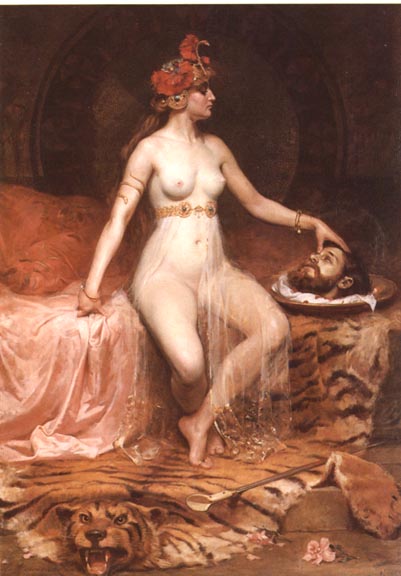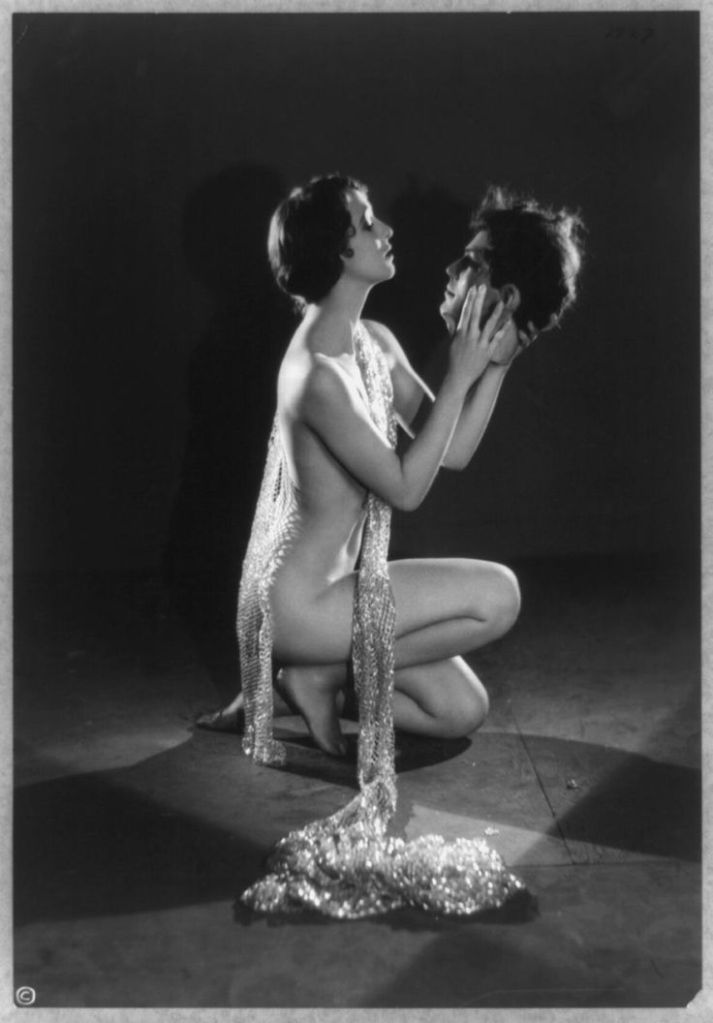
Today is St. John’s Day, the traditional birthday for John the Baptist. Note the timing: just as Christmas is pinned close to the winter solstice, St. John’s Day falls right after the summer solstice. No accident! In America the only folks who still give it much attention are the voodoo practitioners of New Orleans; as a culture we’ve transferred the impulse for a summer holiday to the Fourth of July.
At any rate, we take the occasion to talk about a St. John related fad that swept through American pop culture, especially vaudeville, in the early 20th century: the Salomé craze. If you know your New Testament or your Josephus, you know the tale: how Herod’s wicked step-daughter Salomé did a naughty dance (The Dance of the Seven Veils) for daddy, then demanded and received the head of John the Baptist on a platter. The story was tailor made to be a kink in the Victorian moral armor, Biblical in origin yet titillating. It became a frequent subject for painters in the 19th century.

It finally made its way to the stage (almost) in 1892 with a play by Oscar Wilde. Wilde’s Salomé began rehearsals that year with Sarah Bernhardt as star but was banned by British censors. Something was in the air. The following year Little Egypt made her debut in the Streets of Cairo exhibition in the World Columbian Exposition in Chicago. One used a Biblical justification, the other an anthropological one, but the bottom line was clear: whatever the rationale, people wanted to look at sexy dances. At any rate, Wilde’s Salomé was first published in France in 1893, then in England in 1894, both editions with provocative illustrations by Aubrey Beardsley. The first (private) British production was in 1905, but the ban for public productions was in place until 1931.

But ya know how it is; if you want to create a market for something, forbid it. So, first buzz was created on the continent. In 1902, Max Reinhardt directed a version in Berlin in 1902. Richard Strauss saw this version, and was inspired to adapt it into an opera, which premiered in in 1905. But the crucial leap to the popular stage came the following year.




In 1906 Canadian-born modern dancer Maud Allen premiered her production Visions of Salomé in Vienna. It and she became a sensation. Billed as “The Salomé Dancer” she toured British music halls in 1908, playing 250 stands that year, and published her autobiography. This set off the craze.



Gertrude Hoffman was the first to bring the Salomé dance to the American vaudeville stage in 1908, launching the local mania. Read my short squib on her here, and a much more robust post about the Brooklyn Public Library’s Gertrude Hoffman Collection by scholar/ librarian Ivy Marvel here.

Mademoiselle Dazie was one of the first to imitate Hoffman’s Salomé act and present it on the vaudeville stage though we don’t have a picture of her in costume. Learn more about her here.

A dancer called “La Sylphe” (Edith Lambelle Lagerfeld) also cashed in on the craze. And she had every right to. She was performing her own Salome dance on American stages nearly a decade before the fad took off. More on that pioneering dancer here.

Broadway star Lotta Faust was another who got in on the ground floor, touring vaudeville with a Salomé dance as early as 1908.

Vera Olcott was just a girl of 15 when she garnered press for performing her Salome Dance at Huber’s Museum in 1908. To the general amusement, her knowledge of the actual Salome seems to have been gleaned entirely from other dancers, having no knowledge whatever of the lore or literature the tale was drawn from.


Female impersonator Julian Eltinge also include a Salomé number among his many drag specialties starting in 1908. Another female impersonator who did the Dance of the Seven Veils was British music hall performer Malcolm Scott.

Oscar Hammerstein booked the great star of the Opéra-Comique to perform in the Strauss opera in 1909. She later performed highlights of her performance in vaudeville.

Eva Tanguay’s 1909 Salomé was said to have taken the whole thing up a notch, simulating orgasm, and further increasing her notoriety.

In 1910, the original Funny Girl poked fun at the craze with the song “Sadie Salome, Go Home”, penned by Irving Berlin and Edgar Leslie. Along similar lines, Gus Edwards had cowritten a song called “Sunburnt Salome”, and Ed Wynn had cowritten one called “I’m Going to get Myself a Black Salome”, both in 1908.

African American vaudevillian Aida Overton Walker toured with her Salomé act in 1911.
The Salomé fad had wound down on stages by this point. But in later years, there were some notable films that kept the story out there:

The 1918 film starring the notorious screen vamp Theda Bara is sadly lost — a tragedy for hot-blooded humans everywhere!

The great Russian actress Alla Nazimova’s 1923 screen version was at once too retrograde (it was a long dead fad by the Jazz Age) and too modern (full of art deco design and contemporary dance — who wants a reinterpretation of this quintessential staple?) So it bombed at the box office, although it makes an interesting, if anomalous, artifact.

Mack Sennett Bathing Beauty Kathryn Stanley posed for this publicity still in 1926, although it doesn’t seem to be in support of a Sennett movie (seems to have been a local stage production). Too bad! A Mack Sennett spoof of the subgenre could have been a major hoot, although I’m sure it would have been deemed too blasphemous by religious groups. That John head needs to grow a beard though.

Salomé, Where She Danced (1945)
The 1945 film Salomé, Where She Danced, put Yvonne de Carlo on the map. And what a map! Va va voom!

Salomé (1953)
We sometimes forget that Rita Hayworth started out as a dancer. She reminds us and then some when she does the Dance of the Seven Veils in the 1953 Hollywood film.

Salomé’s Last Dance (1988)
Typically cray-cray Ken Russell version, complete with an Oscar Wilde framing device.

Salomé (2013)
I was lucky enough to see Al Pacino play Herod in Circle in the Square’s 1992 production of Wilde’s Salomé, with Twin Peaks’ Sheryl Lee as the title character. Pacino chewed up the scenery in the play, perhaps the first time the title character had been bumped from the center of her own vehicle. In 2013, he directed his own movie version and — same thing. Jessica Chastain is Salomé , but I had to hunt around for a bit for a photo where Pacino isn’t hogging the limelight! But you can watch the whole thing for real on BroadwayHD. Its well worth subscribing to that worthy service for access to this and scores of other shows! View the 2013 Salomé here.

My version! How could I not include it? In my 2008 revue No Applause, Just Throw Money: The Show That Made Vaudeville Famous at Theater for the New City I cast Leela Corman (best known as an illustrator and graphic novelist, but who is also an accomplished belly dancer) as Salomé, and Art Wallace as the cat-calling head of John the Baptist. And on that sacrilegious note, we end our post.
For more on the history of vaudeville, including fads and phenomena like the Salomé craze, consult No Applause, Just Throw Money: The Book That Made Vaudeville Famous, available at Amazon, Barnes and Noble, and wherever titillating books are sold.

Great post, thank you!
LikeLike
Thanks! and thanks for the tip on the Tanguay picture.
LikeLike